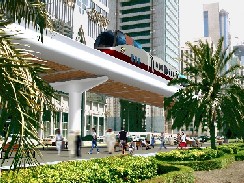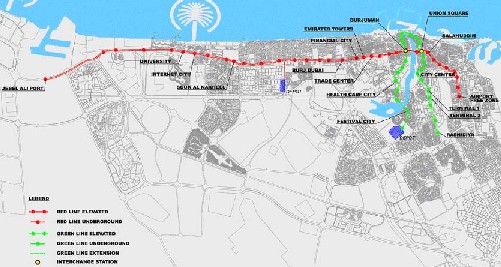|
As
Dubai’s population continues to grow, the need has
arisen for a modern transport system to alleviate
growing congestion on the emirate’s roads. Ben Smalley
reports on the development of the Dubai Metro.
Commuting to work in Dubai invariably involves battling
your way through rush-hour traffic, seething as yet
another inconsiderate driver barges their way into your
lane and then searching for that ever-elusive parking
space within a reasonable walking distance of your
office.
Imagine an altogether different scenario where you get
the chance to read through the morning paper as you sit
in an air-conditioned carriage effortlessly passing the
traffic jams outside the window before alighting at the
nearest station to your place of work. This will be the
reality when the Dubai Metro revolutionises public
transport in the emirate.
The Dh 14.3 billion project was recently given the
go-ahead by the Higher Committee for the Dubai Rail
Project following a massive public consultation exercise
and design studies from Systra, one of the world’s
leading international consulting engineering firms for
rail and urban transport.
Qassim Sultan, Director General of Dubai Municipality
and Chairman of the Higher Committee, says the light
railway project is a testament to Dubai’s faith in the
future, as well as a much needed, hi-tech solution to
the ever-worsening problem of road congestion.
“Look around you and you will see that the vision of our
leaders is truly happening,” he says. “If you have any
doubts about whether Dubai needs a modern public transit
infrastructure, I invite you to witness for yourself the
dynamic growth that Dubai is experiencing.”

The approved design for the
Dubai Metro network comprises
two lines - the Red Line and the Green Line – which will
run underground in the heart of the city and will be
elevated on a specially designed viaduct elsewhere.
Totalling 70km, the two lines will have 55 stations in
all - 35 along the 50 km long Red Line, and 22 stations
along the 20km long Green Line - with two ‘transfer
stations’ at Al Ittihad Square and BurJuman where
passengers can cross from one line to the other.
Construction contracts for the extensive rail network
are currently out to tender and it is anticipated the
first phase of the project will be carrying passengers
by 2009.
The need for the Dubai Metro has been exacerbated by the
city’s increasing population, which is placing
increasing strain on the road network. The population of
Dubai has grown from 183,000 in 1970 to around 1.1
million today, and is expected to
grow at an annual rate of 6.4% to reach 3 million
inhabitants by 2017. Meanwhile, the growth of automobile
ownership has also grown dramatically over the past ten
years, at a rate of over 10% annually, which has
necessitated building more and more roads.
But, according to Nasser Ahmed Saeed, Director of Dubai
Municipality's Roads Department and general coordinator
for the rail project, there is a limit to how many new
roads you can build.
“To meet increases in travel demand during the past
three decades, the municipality has built 9,100 lane km
of roads at a cost of Dhs8.4 billion, and the emirate
just cannot keep on expanding its roads,” he says.
A state-of-the-art urban rail transit system, as well as
being a necessity as the population continues to expand,
will also put Dubai on a par with other major world
cities like London, Hong Kong and Paris and further
develop the prestige of the most dynamic business city
in the Middle East.
Passengers using the Dubai Metro system will travel in
top-of-the-range modern trains, which are fully
air-conditioned and customised to meet the specific
requirements of the emirate. Each train will be about 75
metres long and will consist of five cars featuring
double doors to allow for a fast and smooth flow of
passengers at stations. The trains will offer a standard
class, including women and children only section, as
well as an exclusive first class section, with total
seating for 400 passengers.
With frequencies as high as one every minute and a half,
the fast travelling trains will be powered using a
‘third rail’ connection system which removes the need
for any visually intrusive overhead contact lines. The
driverless trains will be fully automated, and the
electrical traction system will be environmentally
friendly in terms of noise and gas emissions. They will
use either steel wheels or rubber tyres running on a
special double track for full guidance and support, and
all stations will be fully air-conditioned with platform
screen doors for added safety.

The largely straight Red Line will initially run from
Salahuddin Road (near Al Ghurair City) to the American
University of Dubai through BurJuman and Sheikh Zayed
Road, and will later be extended to Jebel Ali Port in
the south and the intersection of Al Nahda and Damascus
roads through Al Qiyadah intersection in the north.
The horseshoe-shaped Green Line will, initially, ply
between Al Ittihad Square (near Dubai Municipality) and
Rashidiya bus station via Deira City Centre and
Terminals 1 and 3 of the airport, and will be extended
to serve the Deira and Bur Dubai central areas up to
BurJuman and Wafi shopping centres. A possible extension
of the Green Line from Wafi City to the upcoming Dubai
Festival City development is currently under study.
In its entirety the metro system will have 18 km of
tunnels, 51 km of viaduct, one major train depot and
maintenance facilities site and several auxiliary
stabling facilities, while the total fleet size is
expected to be around 100 trains.
According to initial projections, the fully operational
system will carry about 1.2 million passengers each
working day with an annual total of about 355 million.
An integrated smart card ticketing system will be
introduced, and some bus stops, taxi stations, and
park-and-ride facilities will be relocated to complement
the metro.
For commuters in Dubai the light rail system promises to
be a time and hassle saving means of getting around the
city, while tourists and other visitors will also
benefit from the ease and convenience of one of the
world’s most advanced metro systems. | 